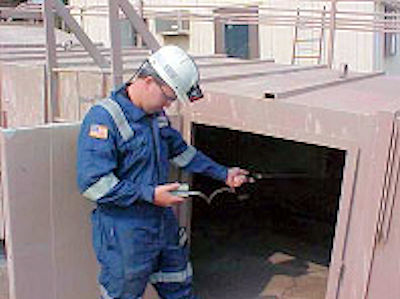34.B.03 Testing Requirements.
- If the testing determines the oxygen is below 19.5% or above 23.5%, or the lower explosive limit (LEL) of 10% is exceeded, or other toxic substances are measured, then the space should be thoroughly ventilated and appropriate PPE used for entry as directed by the CPCSSV. Entry is prohibited when the LEL is greater than 10% unless it is required for emergency rescue.
- Air monitoring must be continuous during entry into the confined space if the oxygen level is not between 19.5% and 23.5% or ventilation was required to lower the explosive limit to below 10% of the LEL.
- Air testing for toxic, corrosive, or irritant chemicals must be made using a calibrated direct reader that provides a reading at a minimum of 50% of the OEL. If the reading is over the OEL, then the space must be ventilated until the value is below the OEL and/or entry must be made with appropriate PPE.
- Before hot work is completed in a confined space with toxic, corrosive, or irritating chemicals, the CPCSSV must conduct an evaluation to confirm the hot work will not create a toxic, corrosive, or irritant atmosphere. This evaluation must be documented and signed by the CPCSSV. During the entry the air must be continually monitored.
- Air sampling must be conducted at the ventilation discharge point if there is anyone in the area or if the discharge is a semi-enclosed or enclosed area.
34.B.04 Entry Precautions.
- No hot work will be completed adjacent to flammable chemicals unless the area is well ventilated and continually tested.
- No ignition source must be taken into an area of flammable chemicals unless the area is well ventilated and continually tested.
34.B.05 Training.
-
Anyone required to enter a potential confined space must be trained when the hazards change or annually, whichever is sooner.
The training must include discussion of the hazards of the space, including the symptoms of any hazardous materials; the controls, including blanking and ventilation; the warnings if the controls fail; personal protective equipment required; and emergency procedures.
- The training on the emergency procedures must include an exercise on retrieving a person from the confined space.
- This training must be documented on a certificate that includes the date of training, name of individual trained, the trainer, and the topics covered. The training certificate must be available for GDA review.
Knowledge Check Choose the best answer for the question.
34-7. When is entry is allowed when the lower explosive limit (LEL) is greater than 10%?
You forgot to answer the question!

